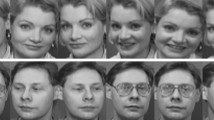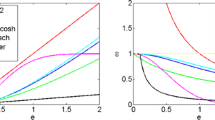Abstract
In recent years, sparse representation-based classification (SRC) has made great progress in face recognition (FR). However, SRC emphasizes noise sparsity too much and it is not suitable for the real world. In this paper, we propose a robust \(l_{2,1}\)-norm Sparse Representation framework that constrains the noise penalty by the \(l_{2,1}\)-norm. The \(l_{2,1} \)-norm takes advantage of both the discriminative nature of the \(l_1 \)-norm and the systemic representation of the \(l_2 \)-norm. In addition, we use the nuclear norm to constrain the coefficient matrix. Motivated by the Fisher criterion, we propose the Fisher discriminant-based \(l_{2,1} \)-norm sparse representation method for FR which utilizes a supervised approach. Thus, we consider the within-class scatter and between-class scatter when all of the label information is available. The paper shows that the model can provide stronger discriminant power than the classical sparse representation models and can be solved by the alternating direction method of multiplier. Additionally, it is robust to the contiguous occlusion noise. Extensive experiments demonstrate that our method achieves significantly better results than SRC and some other sparse representation methods for FR when addressing large regions with contiguous occlusion.








Similar content being viewed by others
Explore related subjects
Discover the latest articles, news and stories from top researchers in related subjects.References
Zhao, W., Chellappa, R., Phillips, P., Rosenfeld, A.: Face recognition: a literature survey. ACM Comput. Surv. 35(4), 399–458 (2003)
Bartlett, M., Movellan, J., Sejnowski, T.: Face recognition by independent component analysis. IEEE Trans. Neural Netw. 13(6), 1450–1464 (2002)
Belhumeur, P., Hespanha, J., Kriegman, D.: Eigenfaces vs. fisherfaces: recognition using class specific linear projection. IEEE Trans. Pattern Anal. Mach. Intell. 19(7), 711–720 (1997)
Turk, M., Pentland, A.: Eigenfaces for recognition. J. Cognit. Neurosci. 3(1), 71–86 (1991)
Zhang, B., Gao, Y., Zhao, S., Liu, J.: Local derivative pattern versus local binary pattern: face recognition with high-order local pattern descriptor. IEEE Trans. Image Process. 19(2), 533–544 (2010)
Tan, X., Triggs, B.: Enhanced local texture feature sets for face recognition under difficult lighting conditions. IEEE Trans. Image Process. 19(6), 1635–1650 (2010)
Ahonen, T., Hadid, A., Pietikainen, M.: Face description with local binary patterns: application to face recognition. IEEE Trans. Pattern Anal. Mach. Intell. 28(12), 2037–2041 (2006)
Ortiz, E.G., Wright, A., Shah, M.: Face recognition in movie trailers via mean sequence sparse representation-based classification. In: Proceedings of the IEEE Conference CVPR, pp. 3531–3538 (2013)
Ocegueda, O., Fang, T., Shah, S., Kakadiaris, I.: 3D-face discriminant analysis using Gauss–Markov posterior marginals. IEEE Trans. Pattern Anal. Mach. Intell. 35(3), 728–739 (2013)
Quan, W., Jiang, Y., Zhang, J., Chen, J.X.: Robust object tracking with active context learning. Vis. Comput. 31(10), 1307–1318 (2015)
Dawn, D.D., Shaikh, S.H.: A comprehensive survey of human action recognition with spatio-temporal interest point (STIP) detector. Vis. Comput. 1–18 (2015). doi:10.1007/s00371-015-1066-2
Wu, J.Z., Hu, D., Chen, F.L.: Action recognition by hidden temporal models. Vis. Comput. 30(12), 1395–1404 (2013)
Hong, J., Aleix, M.: Support vector machines in face recognition with occlusions. In: Conference on Computer Vision and Pattern Recognition, IEEE, pp. 136–141 (2009)
Tan, X., Chen, S., Zhou, Z.H., Liu, J.: Face recognition under occlusions and variant expressions with partial similarity. IEEE Trans. Inf. Forens. Secur. 4(2), 217–230 (2009)
Lee, D., Seung, H., et al.: Learning the parts of objects by non-negative matrix factorization. Nature 401(6755), 788–791 (1999)
Yuen, P., Lai, J.: Face representation using independent component analysis. Pattern Recognit. 35(6), 1247–1257 (2002)
Liu, C., Wechsler, H.: Gabor feature based classification using the enhanced fisher linear discriminant model for face recognition. IEEE Trans. Image Process. 11(4), 467–476 (2002)
Zhou, Z., Wagner, A., Mobahi, H., Wright, J., Ma, Y.: Face recognition with contiguous occlusion using Markov random fields. In: International Conference on Computer Vision, IEEE, pp. 1050–1057 (2009)
Olshausen, B.A., Field, D.J.: Sparse coding with an over-complete basis set: a strategy employed by v1? Vis. Res. 37(23), 3311–3325 (1997)
Vinje, W.E., Gallant, J.L.: Sparse coding and decorrelation in primary visual cortex during natural vision. Science 287(5456), 1273–1276 (2000)
Yuan, X., Yan, S.: Visual classification with multi-task joint sparse representation. In: 2010 IEEE conference on computer vision and pattern recognition (CVPR), vol. 21, pp. 3493–3500. IEEE, San Francisco, CA (2010)
Jenatton, R., Mairal, J., Obozinski, G., Bach, F.: Proximal methods for hierarchical sparse coding. J. Mach. Learn. Res. 12, 2297–2334 (2011)
Chao, Y.W., Yeh, Y.R., Chen, Y.W., Lee, Y.J., Wang, Y.C.F.: Locality-constrained group sparse representation for robust face recognition. In: 18th IEEE international conference on image processing (ICIP), vol. 263, pp. 761–764. IEEE, Brussels (2011)
Wright, J., Yang, A., Ganesh, A., Sastry, S., Ma, Y.: Robust face recognition via sparse representation. IEEE Trans. Pattern Anal. Mach. Intell. 31(2), 210–227 (2009)
Wright, J., Ma, Y., Mairal, J., Ssairo, G., Huang, T., Yan, S.C.: Sparse representation for computer vision and pattern recognition. Proc. IEEE 98(6), 1031–1044 (2010)
Yang, M., Zhang, L., Yang, J., Zhang, D.: Robust sparse coding for face recognition. In: 2011 IEEE Conference on Computer Vision and Pattern Recognition (CVPR), vol. 47, pp. 625–632. IEEE, Providence, RI (2011)
Huang, K., Aviyente, S.: Sparse representation for signal classification. Adv. Neural Inf. Process. Syst. 19, 609–616 (2007)
Wagner, A., Wright, J., Ganesh, A., Zhou, Z.H., Ma, Y.: Towards a practical face recognition system: robust registration and illumination by sparse representation. In: 2009 IEEE Conference on Computer Vision and Pattern Recognition (CVPR), vol. 34, pp. 597–604. IEEE, Miami, FL (2009)
Candes, E.J., Li, X.D., Ma, Y., Wright, J.: Robust principal component analysis? J. ACM 58(1), 1–37 (2011)
Wanger, A., Wright, J., Ganesh, A., Zhou, Z.H., Ma, Y.: Towards a practical face recognition system: robust registration and illumination by sparse representation. IEEE Pattern Anal. Mach. Intell. 34(2), 372–386 (2012)
Wang, J., Lu, C.Y., Wang, M., Li, P.P.: Robust face recognition via adaptive sparse representation. IEEE Trans. Cybern. 44(12), 2368–2378 (2014)
Edouard, G., Guillaume, O., Francis, B.: Trace lasso: a trace norm regularization for correlated designs. In: Proceedings of the Advances in Neural Information Processing Systems, pp. 2187–2195 (2011)
Ou, W.H., You, X.G., Tao, D.C., Zhang, P.Y., et al.: Robust face recognition via occlusion dictionary learning. Pattern Recognit. 47, 1559–1572 (2014)
Lee, H., Battle, A., Raina, R., Ng, A.Y.: Efficient sparse coding algorithms. Adv. Neural Inf. Process. Syst. 19, 801–808 (2007)
Zhang, Z.L., Yu, M., Jia, J., Liu, H., et al.: Fisher discriminant based low rank matrix recovery for face recognition. Pattern Recognit. 47, 3502–3511 (2014)
Liu, G., Lin, Z., Yu, Y.: Robust subspace segmentation by low-rank representation. In: Proceedings of the ICML, pp. 663–670 (2010)
Belhumeur, P.N., Hespanha, J.P., Kriegman, D.J.: Eigenfaces vs fisherface: recognition using class specific linear projection. IEEE Pattern Anal. Mach. Intell. 19(7), 711–720 (1997)
Li, Z., Lin, D., Tang, X.: Nonparametric discriminant analysis for face recognition. IEEE Pattern Anal. Mach. Intell. 31(4), 755–761 (2009)
Lu, J., Tan, Y., Wang, G.: Discriminative multi-manifold analysis for face recognition from a single training sample per person. IEEE Pattern Anal. Mach. Intell. 35(1), 39–51 (2013)
Hua, G., Viola, P., Drucker, S.: Face recognition using discriminatively trained orthogonal rank one tensor projections. In: IEEE Conference on Computer Vision and Pattern Recognition, 2007, CVPR ’07, vol. 7, pp. 1–8. IEEE, Minneapolis, MN (2007)
Gao, Q., Liu, J., Zhang, H., Hou, J., Yang, X.: Enhanced fisher discriminant criterion for image classification. Pattern Recognit. 45(10), 3717–3724 (2012)
Gao, Q., Ma, J., Zhang, H., Gao, X., Liu, Y.: Stable orthogonal discriminant embedding for linear dimensionality reduction. IEEE Trans. Image Process. 22(7), 2521–2531 (2013)
Yang, J., Chu, D., Zhang, L.: Sparse representation classifier steered discriminative projection with applications to face recognition. IEEE Trans. Neural Netw. Learn. Syst. 24(7), 1023–1035 (2013)
Zhang, N., Yang, J.: Low-rank representation based discriminative projection for robust feature extraction. Neurocomputing 111(2), 13–20 (2013)
Ding, C., Zhou, D., He, X.F., Zha, H.Y.: R1-PCA: rotational invariant L1-norm principal component analysis for robust subspace factorization. In: Proceeding of the 23th International Conference on Machine Learning, pp. 281–288 (2006)
Liu, G., Lin, Z., Yan, S., Sun, J., Yu, Y., Ma, Y.: Robust recovery of subspace structures by low-rank representation. IEEE Pattern Anal. Mach. Intell. 35(1), 171–184 (2013)
Belhumeur, P.N., Hespanha, J.P., Kriegman, D.J.: Eigenfaces vs fisherfaces: recognition using class specific linear projection. IEEE Pattern Anal. Mach. Intell. 19(7), 711–720 (1997)
Boyd, S., Vandenberghe, L.: Convex Optimization. Cambridge University Press, Cambridge (2004)
Qian, J.J., Yang, J., Zhang, F.L., Lin, Z.C.: Robust low-rank regularized regression for face recognition with occlusion. In: Computer Vision and Pattern Recognition Workshops, pp. 21–26 (2014)
Yang, J., Zhang, W.Y., Wang, Y.: A fast algorithm for edge-preserving variational multichannel image restoration. SIAM J. Imaging Sci. 2(2), 569–592 (2009)
Cai, J.F., Candes, E.J., Shen, Z.: A singular value thresholding algorithm for matrix completion. SIAM J. Optim. 20(4), 1956–1982 (2010)
Yang, M., Zhang, L., Feng, X.C., Zhang, D.: Fisher discrimination dictionary learning for sparse representation. In: 2011 IEEE International Conference on Computer Vision (ICCV), pp. 543–550. IEEE, Barcelona (2011)
Can, C.Y., Min, H., Gui, J., Zhu, L., Lei, Y.K.: Face recognition via weighted sparse representation. J. Vis. Commun. Image R 24, 111–116 (2013)
Lee, K., Ho, J., Kriegman, D.: Acquiring linear subspaces for face recognition under variable lighting. IEEE Trans. Pattern Anal. Mach. Intell. 27(5), 684–698 (2005)
Georghiades, A., Belhumeur, P., Kriegman, D.: From few to many: illumination cone models for face recognition under variable lighting and pose. IEEE Trans. Pattern Anal. Mach. Intell. 23(6), 643–660 (2001)
Acknowledgments
The research project was supported by the National Natural Foundation of China under Grant No. 61390510, 61300065, 61370119, 61171169 and Beijing Natural Science Foundation No. 4132013, 4142010 and supported by the Beijing science and technology project No. Z151100002115040, and also supported by PHR(IHLB).
Author information
Authors and Affiliations
Corresponding author
Appendix
Appendix
Definitions of \(R_1,R_2,Q,{\hat{Q}}\).
Let \(E_i =[1]_{n_i \times n_i } \) be a matrix of size \(n_i \times n_i \) with all entries being 1, and let \(R_1 =I_{n\times n} -\hbox {diag}(E_i)/n\), \(i=[1,2,\ldots ,c]\); \(R_2 =1/n\,\hbox {diag}(E_i )-1/{nc}\,I_{n\times n};\) \(R(A)=\sum \nolimits _{i=1}^c {\sum _{\begin{array}{c} j=1 \\ j\ne i \end{array}}^c {\Vert {D_j A_i^j}\Vert }_F^2 }, A_i^j\) is the coding coefficient of \(Y_i\) over the sub-dictionary \(D_j\), \(A_i^j\) should have nearly zero coefficients, and thus, we use a select matrix Q with a dot product for the constraint. To facilitate the calculation, we use each row vector of the matrix Q as a diagonal, expanding to a diagonal matrix \({\hat{Q}}\).
Rights and permissions
About this article
Cite this article
Zhao, L., Zhang, Y., Yin, B. et al. Fisher discrimination-based \(l_{2,1} \)-norm sparse representation for face recognition. Vis Comput 32, 1165–1178 (2016). https://doi.org/10.1007/s00371-015-1169-9
Published:
Issue Date:
DOI: https://doi.org/10.1007/s00371-015-1169-9




